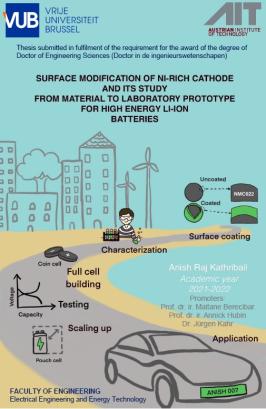
Nickel-rich (LiNixMnyCozO2 (NMC, x+y+z=1; where, x≥0.5)) cathodes are most promising materials for use in the next generation Lithium-ion batteries (LIBs). However, at the highly de-lithiated stages (> 4.3 V vs. Li+/Li) they undergo surface side reactions leading to the safety issue, and structural instabilities. Which results in capacity loss/performance deterioration. To overcome the above-mentioned problems surface coating is considered an efficient strategy.
Hence in the planned thesis, a carbon coating was produced on LiNi0.6Mn0.2Co0.2O2 (NMC622) material. Carbon coatings with two different precursors were performed namely furfuryl alcohol-based (FA) and resorcinol formaldehyde-based (RF) ones. Owing to the better physical and electrochemical properties, FA-based coating was considered for further detailed study. The coating carried out via acid-catalyzed polymerization of furfuryl alcohol, followed by a calcination step. The effect of calcination on the thickness of the coating and electrochemical behavior is in detailed investigated. The coating with ~ 15-20 nm thick carbon layer on top of NMC622, resulted in ~ 8% improved long-term (400 cycles) capacity retention and ~ 50% enhanced high-power (10C) discharge performances compared to uncoated ones. Nevertheless, to understand the effect of calcination on the NMC622, the samples calcined in the same way without coating are carried out and found to improve the performances due to enhanced crystallinity by removal of surface impurities.
Further, to achieve better electrode processing, aqueous-based slurry preparation of uncoated and carbon-coated NMC622 is carried out and compared with the conventional N-methyl-pyrrolidone (NMP) slurry processing. Here the coated materials show better processability i.e. the fabricated electrodes do not show any physical or mechanical instabilities due to their good control over the pH value. The electrochemical tests such as long-term charge-discharge and C-rate performance showed improvement in the carbon coated samples when compared with the uncoated ones. Furthermore, a psuedo-2D isothermal model of uncoated/coated NMC622 was constructed based on the Doyle-Fuller-Newman model. The simulated charge-discharge performance obtained for the uncoated and coated materials at a defined C-rate show an improvement in capacity for the surface coated NMC622 and supports the experimental results. Additionally, to understand the effect of carbon coating the particle vs. carbon coating on the electrode, the carbon coated NMC622 electrode were prepared using magnetron sputtering. The controlled carbon coating thickness of 4 nm, 8 nm, 16 nm, and 32 nm resulted in better electrochemical performances when compared to its uncoated pristine electrode. Especially, the 16 nm carbon coating showed better performances in long-term as well as C-rate analysis.
Additionally, the full cells of uncoated/coated NMC622 vs. graphite were fabricated at the coin cell level. The results showed better electrochemical performance of the coated material at 25°C and 60°C. Finally, to transfer the gained knowledge from the coin cells to a market near LIBs, laboratory prototype pouch cells of the coated and uncoated NMCs were fabricated and found to show good performance. However, to commercialize the technology further optimization of the process is desirable. In this way, the present thesis work shows material to lab prototype study of the surface coated NMC622.
